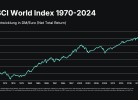By MITCH ZACKS
The election that consumed the American public (and the world) – and also fueled the largest voter turnout in American history – is now over. I won’t get into the weeds on the possible legal challenges to the outcome, and whether they are likely to be successful or not. I’ll focus instead on what’s next for equity markets, assuming the current election result stands.
For its part, the stock market appeared to be unfazed by the swirling uncertainty of the last two weeks. During election week, the S&P 500 clocked its biggest weekly gain since the early days of the new bull market, posting a stout +7.3% gain. For all the commentary about downside volatility surrounding a contested election, the stock market defied expectations – as it often does.
The stock market proves that it responds far more to long-term earnings and economic growth trends over politics. With this election year coming to an end and new positives unfolding within the market, I suggest focusing more on the hard data and economic indicators that could positively impact your investments instead of getting caught up in post-election challenges.
We will see no corporate and capital gains tax increases in at least the next two years
The stock market is arguably looking ahead to a post-pandemic economy and a Biden administration with a divided Congress. In 46 years when power was split between the White House and Congress, the average S&P 500 return was +7.26%. Interestingly, for investors looking for historical stock market data under a Democratic president, a Republican Senate, and a Democratic House, you won’t find any – this division of power has not occurred since 1886.
Wall Street may also be pricing-in some of the policy constraints a Biden administration may face with a divided Congress. In particular, there appears to be little chance we will see corporate and capital gains tax increases in at least the next two years, but perhaps for Biden’s entire term. Any prospect of sweeping legislation that could change property rights or fundamentally alter a sector – like Energy and Health Care – also appear low.
Meanwhile, the prospect of more fiscal stimulus has risen, as Biden has a history of bi-partisan cooperation and both parties agree on the need for more spending (though the amounts vary greatly). The next few years may also feature an ease to trade tensions across the world, and more cooperation with allies in foreign policy affairs. We do not expect any change to monetary policy.
Don’t Forget About the Most Important Stock Market Driver: Corporate Earnings
With all of the focus on the election and policy, perhaps the most important driver of stock market returns over the long-term – corporate earnings – has received very little attention. But that’s a mistake, in my view. I would argue a great deal of the stock market’s recent strength has been driven by earnings.
We now have Q3 earnings results from 447 S&P 500 members (as of November 6), with total earnings for these companies down -7.3% from the same period last year on -1.9% lower revenues. Readers may note the negative performance and wonder how these results can be good. But what matters most with earnings, in our view, is whether a large share of companies are exceeding expectations.
They are! Of the 447 reporting companies, 85.2% of them beat earnings-per-share (EPS) estimates, and 76.3% beat revenue estimates. If 86% ends up being the final percentage of companies exceeding EPS expectations, it will mark the biggest positive EPS surprise since 2008. This metric is a big deal, in my view.
Looking ahead, estimates for Q4 earnings continue to move higher, as corporate America proves more resilient in the pandemic than just about every analyst anticipated.

When it comes to the stock market and earnings, the operative phrase is “better than expected.” And that’s what we’re seeing now.
Bottom Line for Investors
The stock market may also be responding to positive news related to the vaccine. According to reports last week, Pfizer’s vaccine candidate was more than 90% effective in preventing participants from contracting Covid-19 – a very good early sign. Though we are still likely months away from having a vaccine widely available, the light at the end of this pandemic’s tunnel is increasingly visible, in my view.
Stocks have somewhat of a hurdle to climb in the coming year to keep moving higher. As it stands today, the S&P 500 trades at a forward 12-month multiple of 21.6x. This valuation is well above the 10-year average of 15.5x, but as I’ve written before, near-zero interest rates arguably give valuations more wiggle room to the upside. If corporate earnings can catch up in the coming quarters, this bull market may have plenty of room to run.
With the current standing of the market, earnings and the COVID-19 vaccine, we are looking at a bright future ahead in 2021. With that, I recommend not getting caught up in post-election controversy and instead focusing on the long-term outlook.







